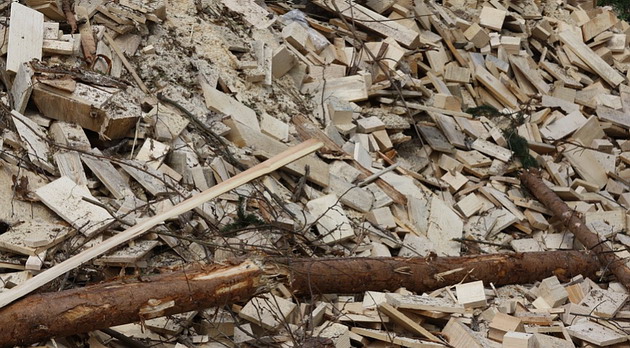Biomass Energy Sources

Biomass energy is a form of renewable energy defined as the energy produced from materials provided by plants and trees, and organic waste provided by animals and people.
All plants and trees on planet Earth are storing chemical energy from the Sun through the photosynthesis process and when we burn the biomass to generate electricity, the chemical energy stored in the biomass is released under the form of heat.
Biomass Energy Definition
Biomass energy is a renewable energy source that can be produced directly by burning plant and tree waste, human trash, and also biogas obtained from animal and human waste.
We can generate biomass energy by burning biomass directly, or by burning biofuels and biogas, which are produced from biomass.
Sources of Biomass Energy
The main sources of biomass on planet Earth are produced by nature, animals and people.
1. Wood and wood waste
Wood is actually the main source of biomass on the planet and is mainly used as solid fuel to heat buildings, but also to produce heat in the industry sector and to generate electricity.
2. Agricultural waste materials
The agricultural sector is a great provider of agricultural waste and energy crops, which can be used directly for heating and for the production of biofuels that can be used to run our vehicles in a greener way.
3. Food waste and garbage
Mankind produces huge quantities of food every day and also tons of garbage, which all represent great sources of biomass energy.
Food waste becomes organic waste and can be used to produce biogas and biofuels.
Wood and other waste materials present in our garbage represent another source of biomass energy which can be used to generate electricity.
4. Human sewage and animal manure
The manure produced by animals and also the human sewage represents another source of organic waste that can be used to produce biogas (which is cleaner than natural gas).
How is Biomass Converted into Energy?
Solid biomass consisting of wood and plant waste and also energy crops can be burned directly to generate heat and electricity.
Biomass represented by wood and plant waste is burned into large boilers to produce steam that is used to spin a large turbine. The turbine will generate clean electricity using generators.
When different types of waste materials such as paper, food waste and yard waste, animal manure and human sewage are decomposed in large scale anaerobic digesters, a gas called biogas is released.
Ethanol is a biofuel produced from corn and sugar cane and can be used to power our vehicles.
Biodiesel is a green fuel created for diesel engines produced from animal fats and vegetable oils and can be used to power vehicles or as heating oil.
Biofuels are classified today in two main categories:
1. First-generation biofuels
First-generation biofuels are food-based biomass that is produced from crops such as sugar cane and corn.
These biofuels rely on the sugars in the biomass to ferment the crops and produce bioethanol.
Ethanol is actually an alcohol that can be used in fuel cells for electricity generation or to improve the quality and the octane number of the gasoline (is used as an additive to gasoline).
2. Second-generation biofuels
Second-generation biofuels are non-food-based biomass and are produced from agricultural, animal and human waste.
Energy crops are better than wood in producing heat.
Producing biofuels (ethanol) from cellulosic biomass (poplar trees) is a very good alternative to food crops.
Biogas is another form of biofuel produced from organic waste materials decomposed in large anaerobic digesters.
How much energy is produced today from biomass?
In the U.S., many boilers used to burn coal have been replaced with biomass boilers to generate electricity, but the share of the biomass energy in the country’s energy mix is still tiny compared to the share of the fossil fuels.
Benefits of Biomass Energy?
Biomass energy uses resources that never run out such as wood, plant and agricultural waste, and also animal and human waste (organic).
1. Reduces the use of energy from fossil fuels
Mankind is already aware of the fact that fossil fuels will eventually run out, and we need to find alternative sources of energy that can replace fossil fuels, but without polluting the environment.
Biomass energy being produced from waste materials, it is considered an energy source of the future because there is no reason to store the waste if we can use it to generate electricity and heat.
Using biomass energy instead of energy produced by burning coal, oil and natural gas we are getting rid of waste and trash and we are keeping the environment cleaner.
2. Is a low-carbon source of power
Biomass energy is not 100% clean because some greenhouse gas emissions are released while burning biomass under the form of solid waste materials (wood, plant waste and trash) and under the form of biofuels.
However, the level of harmful emissions released while burning biomass are way smaller than the level of greenhouse gas emissions released while burning natural gas, oil or coal.
3. Biomass energy has many uses
Solid biomass consisting of wood and plant waste is used today for residential heating and for electricity production.
Biogas produced from organic waste is used today as a green gas (is cleaner than natural gas).
Biofuels are produced from crops (ethanol) and from animal fats and plant waste (biodiesel) are used today in our vehicles to make them cleaner.
Biomass Energy Drawbacks
Biomass energy relies on renewable resources, but has several disadvantages.
1. Is inefficient compared to other energy sources
Solid biomass (wood and plant waste and energy crops) is used for residential heating in many developing countries as an alternative to natural gas (the gas network is poorly developed in these countries).
However, a biomass boiler has only about 24% efficiency, which is way lower than a boiler burning coal (33% efficiency) or a boiler that burns natural gas (43% efficiency).
2. Requires a large storage area for the resource
Wood and plant waste require large areas for storage, and being less efficient than fossil fuels, a power plant needs to burn a large volume of biomass to achieve its output.
To generate biogas, we are using large anaerobic digesters filled with organic waste (animal and human).
3. Can lead to deforestation
Biomass energy is mostly produced from wood and plant waste, and because biomass is less efficient compared to fossil fuels we need to burn larger amounts of wood.
A biomass power plant can lead to deforestation in its area due to the fact that trees regrow much slower than the level of wood consumption required by the power plant to generate energy and heat.
Final conclusion
Biomass energy has a small share in the U.S. energy mix today, but by using all the wood and plant waste available, the trash and the organic waste produced by animals and people every day, we can increase the share of the biomass in the energy mix up to a level where we can replace even a fossil fuel resource with the energy produced from biomass.







